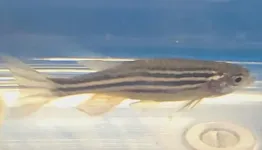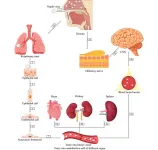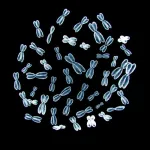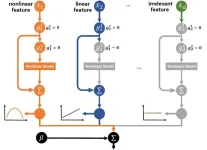Mind’s eye: Pineal gland photoreceptor’s 2 genes help fish detect color
Zebrafish arrestins take turns inactivating key protein depending on intensity of light
2025-01-16
(Press-News.org)
We see color because photoreceptor cones in our eyes detect light waves corresponding to red, green, and blue, while dimness or brightness is detected by photoreceptor rods. Many non-mammalian vertebrates like fish, however, are known to detect color and brightness with the pineal gland, which is part of the brain. An Osaka Metropolitan University research group has further elucidated on how the pineal organ of fish do so.
Previously, the research group led by Professor Akihisa Terakita and Professor Mitsumasa Koyanagi of the Graduate School of Science revealed that the pineal organ of bony fish detects colors using a different mechanism than that of their eyes. A type of pineal photoreceptor cell that contains a protein called parapinopsin 1 (PP1) detects color.
These PP1 cells become active and inactive in proportion to the difference in wavelength of light, with longer waves for red and shorter ones for blue, for example. This inactivation of PP1 has been found necessary for color detection, but the mechanism has now been discovered.
Using zebrafish, the team investigated arrestin proteins in the pineal gland involved in the inactivation of photoreceptor proteins such as PP1. Of the seven types of arrestins in zebrafish, the researchers found that Sagb and Arr3a play major roles with PP1.
Arr3a rapidly inactivates PP1 when light is dim, while Sagb takes over inactivation when light intensity increases. The team found that the dual performance of this single photoreceptor is dependent on the switching of these two arrestins according to the intensity of light.
“Multiple types of arrestins exist in a single cell. Our discovery suggests that the function of arrestins might be used differently depending on the strength of the stimulus, an important finding about these genes,” Professor Koyanagi proclaimed.
Professor Terakita added, “The elucidation of the mechanism of color discrimination by a single type of photoreceptor protein is expected to contribute to the realization of optogenetics, which uses parapinopsin to control cells by the color of light.”
The findings are published in iScience.
###
About OMU
Established in Osaka as one of the largest public universities in Japan, Osaka Metropolitan University is committed to shaping the future of society through “Convergence of Knowledge” and the promotion of world-class research. For more research news, visit https://www.omu.ac.jp/en/ and follow us on social media: X, Facebook, Instagram, LinkedIn.
END
[Attachments] See images for this press release:

ELSE PRESS RELEASES FROM THIS DATE:
2025-01-16
Nipah virus (NiV), a zoonotic paramyxovirus with significant human health implications, has garnered considerable attention due to its high fatality rates and potential for human-to-human transmission, posing a global public health threat. Emerging in South and Southeast Asia, NiV is known for its recurrent outbreaks, with a particular focus on its genetic lineages, NiV-MY and NiV-BD, which differ in pathogenicity and transmissibility. The virus, initially isolated in Malaysia in 1998, has since caused outbreaks linked to contact with infected ...
2025-01-16
FDA BANS RED DYE 3 IN FOOD AND INGESTED DRUGS
Citing two studies linking Red Dye 3 to cancer in laboratory male rats, the FDA today revoked authorization for the use of the dye in food and ingested drugs. The move came in response to a 2022 color additive petition. “This is long overdue,” said Tracy Crane, Ph.D., RDN., director of Lifestyle Medicine and Prevention at Sylvester. “Red Dye 3 has been banned for use in cosmetics and topical drugs for more than three decades,” she said. “Yet it gives more than 9,000 foods in the United States their red coloring. These colorful foods and drinks are particularly appealing to young children,” ...
2025-01-16
KYOTO – An international team of researchers has taken an important step toward understanding how gene expression is controlled across the human genome. A new study has comprehensively analyzed “cis-regulatory elements” (CREs), which are the DNA sequences that regulate gene transcription. This work sheds light on how these elements contribute to cell-specific gene expression and how mutations within them may influence health and disease.
CREs, including enhancers and promoters, are essential for controlling when and where genes are ...
2025-01-16
In a study of more than 5,000 mothers and their children, exposure to air pollution during the three months before pregnancy predicted higher child body mass index (BMI) and related obesity risk factors up to two years of age. Findings from the study, which was supported by the National Institute of Environmental Health Sciences, were published in the journal Environmental Research.
Past research has linked air pollution exposure during pregnancy to a broad range of health problems in children, including respiratory ...
2025-01-16
Interpretability has drawn increasing attention in machine learning. Partially linear additive models provide an attractive middle ground between the simplicity of generalized linear model and the flexibility of generalized additive model, and are important models for addressing the two interpretability problems of feature selection and structure discovery. The existing partially linear additive models still have various imperfect performances in terms of fitting ability.
To solve the problems, a research team lad by Han LI published their new research on 15 December 2024 in Frontiers of Computer Science co-published by Higher Education Press and Springer Nature.
The ...
2025-01-16
Researchers have used dung records to create high-resolution maps of herbivore distribution around the world. Their new study, recently published in Nature Food, reveals a strong positive relationship between dung presence and grazing pressure, meaning the amount of dung found in a particular location could help us understand approximately how many herbivores live there.
Many people consider dung simply as the manure left behind by horses and cows at country shows, or something to be avoided when you visit the cousins’ farm. But dung is actually an important resource for millions of people worldwide.
Dung ...
2025-01-16
Senior midwives and researchers with experience in criminal and social justice are among those calling for improved maternity provision for pregnant women in UK prisons.
In an article published by The BMJ today, Laura Abbott and colleagues highlight gaps in clinical care for pregnant women and say the systemic problems need tackling urgently to protect the health of pregnant women, new mothers, and babies while in criminal justice settings.
Figures from April 2023 to March 2024 show that 229 pregnant women ...
2025-01-16
The UK needs an overarching national strategy to tackle alcohol related harms, argue experts in The BMJ today, as deaths from alcohol in England reach their highest level on record.
Julia Sinclair at the University of Southampton and colleagues warn that successive government cuts have led to reduced provision and quality of alcohol treatment, and say sustained funding is needed for screening and care, while industry must also shoulder some of the costs.
Alcohol is widely available and drunk by around 80% of adults in the UK and is now well established as ...
2025-01-16
Regular aerobic exercise could significantly reduce disease markers associated with Alzheimer’s, new research led by scientists at the University of Bristol (UK) and the Federal University of São Paulo (Brazil) has found. The findings provide new hope in the battle against this devastating disorder.
Published in the journal Brain Research, the study highlights how physical activity not only protects healthy brain cells but also restores balance in the aging brain.
The research focused on ...
2025-01-16
Cambridge researchers are leading the first phase of a new research project that will lay the groundwork for future studies into the impact on children of smartphone and social media use.
The work has been commissioned by the UK government’s Department for Science, Innovation and Technology after a review by the UK Chief Medical Officer in 2019 found the evidence base around the links to children’s mental health were insufficient to provide strong conclusions suitable to inform policy.
The project – led by a team at the University of Cambridge, in collaboration with researchers at several leading UK universities ...
LAST 30 PRESS RELEASES:
[Press-News.org] Mind’s eye: Pineal gland photoreceptor’s 2 genes help fish detect color
Zebrafish arrestins take turns inactivating key protein depending on intensity of light





